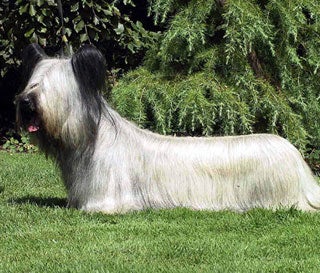Learn about dog breeds
Detailed information & photos on over 190 different breeds
Description
Skye Terriers are elegant dogs that average ten inches in height and weight between twenty and forty pounds. Two times longer than they are high at the withers, they are level, low, and long. Their profuse coat of hair falls straight down over oval shaped ribs. The well-feathered hair on the Skye Terriers head covers their eyes and forehead, protecting them from briar and brush or run-ins with other animals. These elegant, dignified dogs walk with their head high, move with an effortless gait, and have a long, hanging tail. Skye Terriers have close-set, medium sized, dark brown eyes; a black nose; and gracefully feathered upright ears. They are double-coated with a soft undercoat and a six-inch straight, hard outer coat parting down the middle of the Skye Terriers back.
Coat Description
The Skye terrier have a soft, close, woolly, short undercoat and a straight, hard, long, outer coat. The body coat of the Skye terrier parts from tail to head and hangs down the sides. They have long feathering that falls straight down on the ears from the outer edges and tips. The Skye has fur around the face and mouth giving a beard-like appearance. Their coat can be fawn, cream, silver platinum, light or dark grey, blue or black with dark or black points on the tip of the tail, muzzle, and ears.
History
Some believe that Skye terriers originated in Scotland on the Isle of Skye over four centuries ago. Locals used them to hunt fox, badger, and other vermin. Although widely disputed, many believe that in the sixteen hundreds a Spanish ship crashed against the Island of Skye’s rocky shore. The Maltese dogs that were on that ship and made it safely to shore, bred with local dogs creating a new breed. In 1864 in England, they showed the first Skye terrier and twenty-three years later, the American Kennel Club registered them. Although the Skye terrier can still aid in controlling rats and other vermin, it is primarily a companion animal today.
Temperament
Skye terriers are affectionate, easy going, loving dogs that are also bold, spunky, and courageous. Skye are confident, playful, loving medium-sized dogs that require lots of attention from their human family to be happy. Wary of strangers, they require early socialization and training to get along with children, strangers, other dogs and animals. They dislike anyone touching them and when nervous around someone, may bark or bite. It is important to keep Skye terriers on a leash when outdoors as they are natural chasers and will run after squirrels, dogs, other animals, and moving objects. Without proper socialization, the Skye terrier is not suitable in a home with smaller pets and young children.
Health Problems
Although the Skye terrier is a healthy breed of dog, there are a few health issues to be aware of including orthopedic problems. These problems could occur during the dog’s growth period because of their small, short legs and larger body. Avoid strenuous activity such as long walks, jumping, and climbing until the puppy reaches eight to ten months old or it could end up with bowed legs or a permanent limp. If the Skye terrier has Hyperthyroidism, which is an overactive thyroid gland producing excessive thyroid hormones, the dog may move faster than normal and lose weight. They normally try to monitor and control the Hyperthyroidism is with medication. A cancer that quickly spreads to other body locations, Mammary Cancer is one of the main causes of Skye terrier deaths.
Grooming
The luxurious, long, average shedding coat of the Skye terrier requires brushing once or twice a week using either a long toothed comb or pin brush, to keep from becoming matted. This also removes any dead or loose hair and dander, keeping the dog’s coat looking wonderful. Very different from the adult Skye Terriers coat, puppy coats take from eighteen months to two years to change. Only bathe the Skye terrier when necessary using a good quality dog shampoo and conditioner, but be sure to remove any mats or tangles first as they are almost impossible to get out when wet. Their natural feathered coat does not require trimming but the area between the pads of their feet may need occasional clipping.
Brush the dog’s teeth a minimum of three times weekly to remove bacteria and tartar buildup and clip their nails monthly, or more often if needed. When grooming the Skye terrier, always watch for any signs of problems or infection such as odor from their ears or inflamed skin.
Exercise
Skye Terriers are suited for country, city or suburban living, in an apartment, condominium, or large mansion, as long as they have a quiet home environment with lots of companionship. They enjoy a fenced yard to move about at their leisure. Skye Terriers do not need a lot of exercise so are a great choice for disabled owners that cannot take their companion animal on long walks, older owners, or people that do not have the time or want to walk a dog.
Training
It is easy to train a Sky terrier using praise, patience, consistency, and persistence. You must keep training sessions short, interesting, positive and fun because Skye Terriers become bored easily. Socialization is very important at a young age so it is important to expose the puppy to as many new sights, sounds, places, people, animals, and situations as possible. They need to learn how to interact with strangers, other animals, and children without being overly aggressive and biting or barking.
Advertise | Privacy Policy | Terms of Use | Contact Us © Copyright 2004-2024 PupCity.com. All rights reserved.
